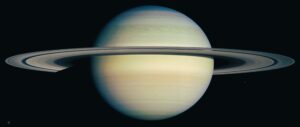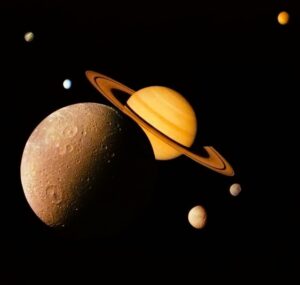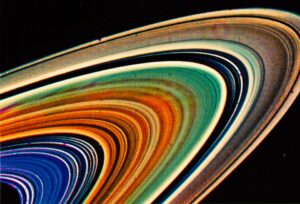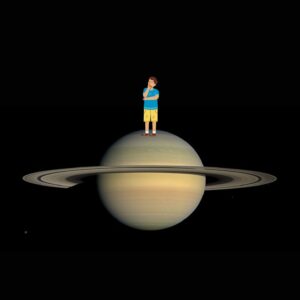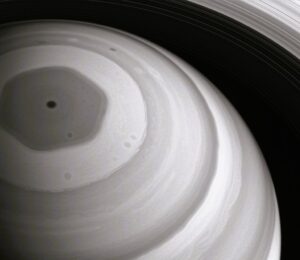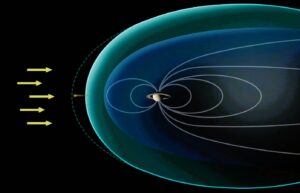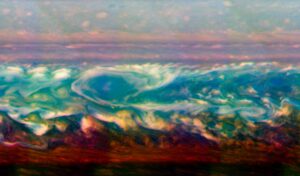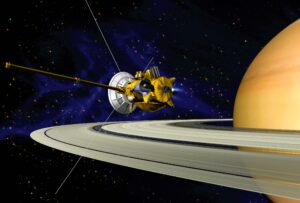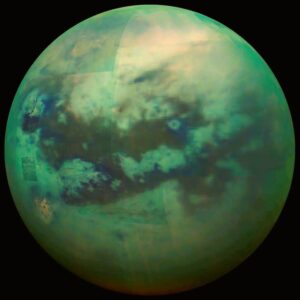- abaashishb7
- April 9, 2024
- 3:10 pm
- No Comments
Saturn Planet
शनी ग्रह
* Saturn : Impression of The Space World
Saturn, the sixth planet from the Sun and the second-largest in our solar system, is a
mesmerizing gas giant famous for its stunning rings. Named after the Roman god of
agriculture, Saturn has captivated astronomers and stargazers for centuries with its
beauty and unique features.
* Discovery of saturn
Saturn is one of the most recognizable planets in our solar system, known for its stunning rings. Its discovery cannot be credited to a single person, as it has been observed since ancient times.
1:- Ancient Observations: Saturn is visible to the naked eye from Earth and has been
observed for thousands of years. Ancient civilizations such as the Babylonians,
Greeks, and Romans recorded its movements in the sky.
2:- Galileo Galilei: In 1610, Galileo Galilei was the first to observe Saturn through a
telescope. However, his telescope was not powerful enough to see the rings clearly,
leading him to describe Saturn as having “ears” or a “handle.”
3:- Christiaan Huygens: In 1655, Huygens was the first to correctly identify Saturn’s rings
as a disk surrounding the planet. He used a more powerful telescope to make this
discovery.
4:- Giovanni Cassini: In the late 17th century, Cassini made further discoveries about
Saturn. He observed a gap in the rings now known as the Cassini Division, as well as
four of Saturn’s moons: Iapetus, Rhea, Tethys, and Dione.
5:- Modern Observations: With advancements in telescopes and space exploration,
scientists have continued to study Saturn. NASA’s Voyager 1 and 2 spacecraft
provided detailed images of the planet and its moons in the 1980s. The Cassini
spacecraft, launched in 1997, spent over 13 years orbiting Saturn and provided
unprecedented views of its rings, moons, and atmosphere.
* Dimension Of Saturn
1:- Diameter: Saturn has an equatorial diameter of about 120,536 kilometers
(74,898 miles). This makes it the second-largest planet in our solar system, after
Jupiter.
2:- Polar Diameter: The polar diameter of Saturn is slightly smaller than its equatorial
diameter, measuring around 108,728 kilometers (67,560 miles). This variation is due
to its rapid rotation, which causes the planet to bulge slightly at the equator.
3:- Circumference: The circumference of Saturn around its equator is approximately
378,675 kilometers (235,298 miles).
4:- Surface Area: Saturn’s total surface area, including its rings, is approximately 42.7
billion square kilometers (16.5 billion square miles). However, Saturn is a gas giant
without a solid surface, so this surface area is more of an abstract concept relating
to its gaseous atmosphere.
5:- Volume: The volume of Saturn is about 827.13 trillion cubic kilometers (198.37
trillion cubic miles). This vast volume is mainly composed of hydrogen and helium,
the two primary elements in its atmosphere.
6:- Mass: The mass of Saturn, the sixth planet from the Sun, is approximately 5.683 ×
10^26 kilograms. This mass makes Saturn the second-most massive planet in our
solar system, after Jupiter. To put it into perspective, Saturn’s mass is about 95 times
that of Earth.
These dimensions give an idea of the immense size of Saturn, a gas giant with a mass over 95 times that of Earth. Despite its enormous size, Saturn’s density is low compared to Earth, so if there were a large enough ocean, Saturn would float in it.
* Key Fact of Saturn
Distance from the Sun
1:- Average Distance: Approximately 1.4 billion kilometers (886 million miles)
Perihelion (Closest Approach to Sun): About 1.35 billion kilometers
(839 million miles)
Aphelion (Farthest Distance from Sun): Around 1.5 billion kilometers(932 million miles)
Orbital Period (Year)
This Planet takes about 29.5 Earth years to complete one orbit around the Sun.
Day Length
A day on This Planet (one full rotation on its axis) lasts about 10.7 Earth hours.
Size
1:- Diameter: Approximately 120,536 kilometers (74,898 miles)
This Planet is the second-largest planet in our solar system, about nine times wider
than Earth.
Gravity
Surface Gravity: About 10.44 m/s² (equivalent to 1.06 times Earth’s gravity)
Appearance
This Planet is a gas giant with a pale yellow hue. Its most prominent feature is its
magnificent ring system, which is made up of countless particles of ice and rock.
The rings extend thousands of kilometers from This Planet’s equator, but they are
incredibly thin, only about 10 meters (33 feet) thick.
Surface Features
This Planet, like Jupiter, does not have a solid surface. It is mostly composed of
hydrogen and helium with no distinct solid ground.
However, its upper atmosphere features bands of clouds, with dark and light areas
caused by different compositions and temperatures.
One notable feature is the hexagonal storm at This Planet’s north pole, first observed by
the Cassini spacecraft.
Atmosphere
1:- Composition: This Planet’s atmosphere is primarily composed of hydrogen
(about 96%) and helium (about 3%), with traces of other gases including methane,
ammonia, and water vapor.
2:- Cloud Layers: The upper layers of This Planet’s atmosphere have clouds made of
ammonia ice crystals and other compounds.The strong winds in This Planet’s
atmosphere create a variety of storm systems and cloud patterns.
Moons
This Planet has a vast system of moons, with over 80 confirmed satellites.
Some of the largest and most well-known moons include:
1:- Titan: This Planet’s largest moon, with a thick atmosphere and lakes of liquid
methane and ethane.
2:- Enceladus: A small moon with a subsurface ocean beneath its icy crust, known for its
geysers of water vapor and ice.
3:- Rhea, Dione, Tethys, and Iapetus: Other significant moons with diverse features, such
as ancient craters and icy surfaces.
* Composition of Saturn
The composition of Saturn’s atmosphere and interior primarily consists of hydrogen and
helium, much like Jupiter. However, there are also trace amounts of other compounds.
Here’s a breakdown of Saturn’s composition
1:- Hydrogen (H2):
The majority of Saturn’s atmosphere is hydrogen, making up about 96% of its
composition by volume.
2:- Helium (He):
Helium is the second most abundant element in Saturn’s atmosphere, comprising
about 3% of its composition.
Other Gases
1:- Methane (CH4): Saturn’s atmosphere contains traces of methane, which gives it its
pale yellow color. Methane absorbs red light and reflects yellowish-brown light,
contributing to Saturn’s appearance.
2:- Ammonia (NH3): Ammonia is another trace gas found in Saturn’s atmosphere,
contributing to the formation of clouds in its upper layers.
3:- Water Vapor (H2O): Like Jupiter, Saturn’s atmosphere has small amounts of water
vapor, which can condense into clouds at various altitudes.
4:- Hydrogen Deuteride (HD): This compound, a combination of hydrogen and deuterium,
is found in Saturn’s atmosphere.
5:- Other Trace Gases: There are also traces of other compounds such as
ethane (C2H6), phosphine (PH3), and others.
Saturn’s atmosphere is layered, with different temperature and pressure zones. The
visible atmosphere we see from space is mostly made up of hydrogen and helium, while
the deeper layers consist of hydrogen under higher pressure.
In terms of its interior, Saturn is believed to have a core made of rock and ice,
surrounded by a layer of liquid metallic hydrogen, and then an outer layer of molecular
hydrogen gas. The pressure and temperature within Saturn are so extreme that
hydrogen transitions from a gas to a liquid metal in the deeper layers, creating a
magnetic field and generating heat.
These elements and compounds combine to give Saturn its unique appearance and
characteristics, from its beautiful rings to its colorful cloud bands and dynamic weather
systems.
* Structure of Saturn
Core
Saturn is believed to have a solid core at its center, composed of rock and ice.
This core is relatively small compared to the planet’s overall size.
The core’s exact size and composition are not precisely known and are still the subject
of study.
Rock/Ice Layer
Surrounding the core, there is a layer of rock and ice.
This layer contains elements like water, methane, and ammonia, which are solid under
the intense pressure and temperature deep within Saturn.
Liquid Metallic Hydrogen Layer
Above the rock/ice layer, there is a region where hydrogen is under so much pressure
that it becomes a liquid metal.
This layer of liquid metallic hydrogen is a key feature of gas giants like Saturn and
Jupiter. It is highly conductive and is believed to be responsible for generating Saturn’s
strong magnetic field.
Liquid Hydrogen Layer
Surrounding the layer of metallic hydrogen is a region of liquid hydrogen.
This layer is believed to be in a supercritical state, behaving like both a liquid and a gas
due to the extreme pressure and temperature.
Molecular Hydrogen Layer
Above the liquid hydrogen layer, there is a layer of molecular hydrogen gas.
This layer gradually transitions into This Planet’s visible atmosphere.
The molecular hydrogen layer extends upward into the atmosphere, becoming less
dense and transitioning into the upper layers of clouds.
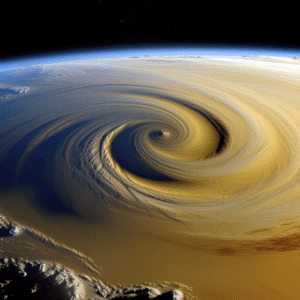
Atmosphere
The outermost layer of This Planet is its thick atmosphere, primarily composed of
hydrogen and helium.
The atmosphere contains multiple cloud layers, with colors and patterns determined by
different compounds and temperatures.
This Planet’s atmosphere features bands of clouds, storms, and wind patterns. The
bands are created by different wind speeds and compositions of cloud particles.
Rings
While not a part of This Planet’s internal structure, its iconic rings are a defining feature.
The rings are composed of countless icy particles ranging in size from dust grains to
large boulders.
These particles orbit This Planet in a thin disk-like structure, reflecting sunlight and
creating a stunning visual display.
* What Would Happen if a Human Were to Enter Saturn
Entering Saturn’s atmosphere or attempting to land on the planet itself would be
extremely challenging and ultimately fatal for a human. Here’s what would likely happen:
Descent through the Atmosphere
As a human descends into Saturn’s atmosphere, they would encounter immense
pressures. Saturn’s atmospheric pressure increases rapidly with depth, reaching
pressures of over 100,000 times Earth’s atmospheric pressure at sea level.
This extreme pressure would crush the human body almost instantly. It would be similar
to being crushed by the pressure of an ocean many kilometers deep.
Heat
Saturn’s atmosphere is also incredibly hot, with temperatures increasing the deeper you
go. Near the top of the atmosphere, temperatures can reach around -185 degrees
Celsius (-300 degrees Fahrenheit).
However, as you descend, the temperature rises due to the heat generated by Saturn’s
interior.
Eventually, the heat would become intense enough to vaporize and then incinerate the
human body.
Chemical Composition
This Planet’s atmosphere is primarily composed of hydrogen and helium, with trace
amounts of other gases like methane and ammonia.
The lack of oxygen would mean that a human could not breathe in This Planet’s
atmosphere. Without a suit supplying oxygen, the person would quickly suffocate.
Wind and Turbulence
This Planet has incredibly strong winds and turbulent weather systems.
Wind speeds can exceed 1,800 kilometers per hour (1,100 miles per hour) in This
Planet’s upper atmosphere.
These powerful winds would likely tear apart any human-sized object long before
reaching deeper layers.
No Solid Surface
Like Jupiter, This Planet does not have a solid surface like the terrestrial planets.
Its “surface” is a transition zone where the atmosphere becomes denser and turns into a
liquid. There is no solid ground to stand on or land upon.
if a human were somehow able to enter This Planet’s atmosphere, they
would be crushed, burned, suffocated, and torn apart by the extreme conditions long
before reaching any solid “surface” that This Planet might have. It’s a lethal combination
of intense pressure, heat, lack of breathable air, and violent weather that makes This
Planet completely inhospitable to humans.
* Unique Characteristics of Saturn
Magnificent Rings
Saturn’s rings are perhaps its most famous feature, composed of billions of particles of
ice, rock, and dust.
These rings extend outward from the planet’s equator for thousands of kilometers.
Saturn’s rings are extraordinarily thin, only about 10 meters (33 feet) thick, but can span
up to 282,000 kilometers (175,000 miles) in diameter.
The rings are made up of several main rings named alphabetically in order of discovery,
from the innermost D-ring to the outermost A-ring.
Second Largest Planet
Saturn is the second-largest planet in our solar system, after Jupiter.
It has a diameter of approximately 120,536 kilometers (74,898 miles), making it about
nine times wider than Earth.
Low Density
Despite its massive size, Saturn is less dense than water.
Its average density is about 0.687 grams per cubic centimeter, making it one of the least
dense planets in our solar system.
Rapid Rotation
Saturn rotates on its axis very quickly, completing a full rotation in about 10.7 Earth
hours. This rapid rotation causes Saturn to flatten slightly at the poles and bulge at the
equator, giving it an oblate shape.
Unique Hexagonal Storm
At This Planet’s north pole, there is a remarkable hexagonal-shaped storm system.
This unusual and persistent feature was first discovered by the Voyager spacecraft in
the early 1980s and continues to intrigue scientists.
Diverse Moons
This Planet has a vast system of moons, with over 80 confirmed satellites.
Among these, Titan stands out as the largest moon, even larger than the planet Mercury.
Enceladus is another notable moon with geysers of water vapor and ice erupting from its
surface.
Strong Magnetic Field
This Planet has a powerful magnetic field, though it is slightly weaker than Jupiter’s.
This magnetic field extends far into space and is responsible for trapping charged
particles and creating auroras near its poles.
Colorful Atmosphere
This Planet’s atmosphere is mainly composed of hydrogen and helium, with traces of
other gases like methane and ammonia.
The bands and zones in This Planet’s atmosphere exhibit various colors and patterns
due to different compositions and temperatures.
The pale yellow color of This Planet’s atmosphere is due to the presence of trace
amounts of methane, which absorbs red light and reflects yellowish-brown light.
* Modern Exploration of Saturn
Cassini-Huygens Mission
The Cassini spacecraft, a joint mission by NASA, the European Space Agency (ESA), and
the Italian Space Agency (ASI), was launched in 1997 and arrived at Saturn in 2004.
Cassini provided an unprecedented close-up view of Saturn, its rings, and its moons,
sending back a wealth of data and stunning images.
The Huygens probe, part of the Cassini mission, successfully landed on Saturn’s largest
moon, Titan, in 2005. It provided the first-ever direct measurements of Titan’s
atmosphere and surface.
Exploration of Titan
Titan, Saturn’s largest moon, is one of the most intriguing objects in our solar system.
Cassini revealed Titan’s surface features, including lakes and rivers of liquid methane
and ethane. Observations by Cassini and the Huygens probe suggest that Titan has a
subsurface ocean of liquid water beneath its icy crust, making it a prime target for
astrobiological studies.
Geysers on Enceladus
Enceladus, another of Saturn’s moons, was found to have geysers of water vapor and ice
erupting from its south polar region.
Cassini made multiple flybys of Enceladus, analyzing the composition of the plumes and
discovering organic molecules, water vapor, and salts.
These findings indicate that Enceladus has a subsurface ocean beneath its icy shell,
making it another potential target in the search for life beyond Earth.
Dynamic Rings
Cassini’s observations of This Planet’s rings revealed their dynamic and ever-changing
nature. The spacecraft captured images of small moonlets within the rings, as well as
intricate structures and patterns caused by gravitational interactions with This Planet’s
moons.
These observations helped scientists better understand the origins and evolution of This
Planet’s ring system.
Hexagonal Storm on This Planet
The hexagonal-shaped storm at This Planet’s north pole, first observed by the Voyager
spacecraft, continued to intrigue scientists.
Cassini provided high-resolution images and data of this unique feature, shedding light
on its formation and dynamics.
Magnetic Field and Auroras
Cassini’s measurements of This Planet’s magnetic field provided insights into its
complex and dynamic nature.
The spacecraft also observed powerful auroras at This Planet’s poles, created by
interactions between the planet’s magnetic field and charged particles from the solar
wind.
End of the Cassini Mission
The Cassini spacecraft’s mission came to an end in 2017 with a deliberate plunge into
This Planet’s atmosphere.
This “Grand Finale” provided valuable data on This Planet’s upper atmosphere and
allowed scientists to study the planet’s composition and structure in unprecedented
detail.
These discoveries and missions have greatly expanded our understanding of This Planet
and its diverse moons. They have revealed a dynamic and complex system with the
potential for habitable environments on moons like Titan and Enceladus. This Planet
continues to be a focus of scientific research and exploration, with future missions
planned to further unravel its mysteries.
- abaashishb7
- April 9, 2024
- 3:10 pm
- No Comments


